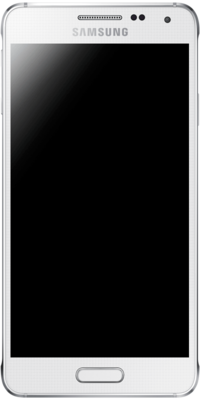Samsung Galaxy Alpha
 |
|

Samsung Galaxy Alpha in White
|
|
| Brand | Samsung Galaxy |
|---|---|
| Manufacturer | Samsung Electronics |
| Slogan | Just Alpha. |
| Series | Galaxy A series |
| Compatible networks | (GSM/GPRS/EDGE): 850, 900, 1,800 and 1,900 MHz; 3G (HSDPA 42.2 Mbit/s, HSUPA 5.76 Mbit/s): 850, 900, 1,900 and 2,100 MHz; LTE: 800, 850, 900, 1,800, 2,100 and 2,600 MHz 3G TD-SCDMA 1900 / 2000 MHz LTE-TDD |
| Successor | Samsung Galaxy A3, A5 & A7 family |
| Related |
Samsung Galaxy S5 Samsung Galaxy S5 Mini |
| Type | Touchscreen smartphone |
| Form factor | Slate |
| Dimensions | 132.4 mm (5.21 in) H 65.5 mm (2.58 in) W 6.7 mm (0.26 in) D |
| Weight | 115 g (4.1 oz) |
| Operating system |
Original: Android 4.4.4 "KitKat" Current: Android 5.0.2 "Lollipop" |
| System on chip | Exynos 5 Octa 5430(Global) & Qualcomm Snapdragon 801 MSM8974AC (U.S & China) |
| CPU | ARM Big Little(ARM Cortex-A15 MP4 1.8 GHz CPU + ARM Cortex-A7 MP4 1.3 GHz CPU)(Global) & Qualcomm Krait 400 MP4 2.5 Ghz(U.S & China) |
| GPU | ARM Mali T628MP6 (Global) & Qualcomm Adreno 330 578 Mhz(U.S & China) |
| Storage | 32 GB |
| Battery | Replaceable 1860 mAh Li-ion-Battery |
| Data inputs |
List
|
| Display | 4.7 in (120 mm) 1280×720 px Super AMOLED (312 ppi) |
| Rear camera |
12 megapixels |
| Front camera | 2.1 megapixels (1080p) HD video recording @ 30 fps back-illuminated sensor |
| Connectivity | |
| References | |
12 megapixels
Samsung Galaxy Alpha is an Android smartphone produced by Samsung Electronics. Unveiled on August 13, 2014, the device was released in September 2014. A high-end device, the Galaxy Alpha is Samsung's first smartphone to incorporate a metallic frame, although the remainder of its physical appearance still resembles previous models such as the Galaxy S5. It also incorporates Samsung's new Exynos 5430 system-on-chip, which is the first mobile system-on-chip to use a 20 nanometer manufacturing process.
The Galaxy Alpha or Note 4 Mini received mixed reviews: although praised for its higher quality build and design in comparison to earlier products, the device was panned for its modest specifications in comparison to its flagship counterpart, the Galaxy S5, and for being priced too high for what they considered to be a "mid-range" smartphone.
Samsung has historically been criticized for its continued use of low-quality polycarbonate materials on its flagship smartphone products, even as its competitors have made phones utilizing higher quality plastics or unibody aluminium frames. Despite these issues with build quality, Samsung has still been considered the most dominant Android OEM. However, in July 2014, the company reported its lowest profits in over two years, and a drop in market share from 32.3% to 25.2% over the past year. The loss in market share was attributed primarily to growing competition from vendors such as HTC and LG, and similarly increased competition in the low and mid-range markets from vendors such as Huawei and Motorola (who is currently in the process of being sold by Google to Lenovo).
...
Wikipedia
